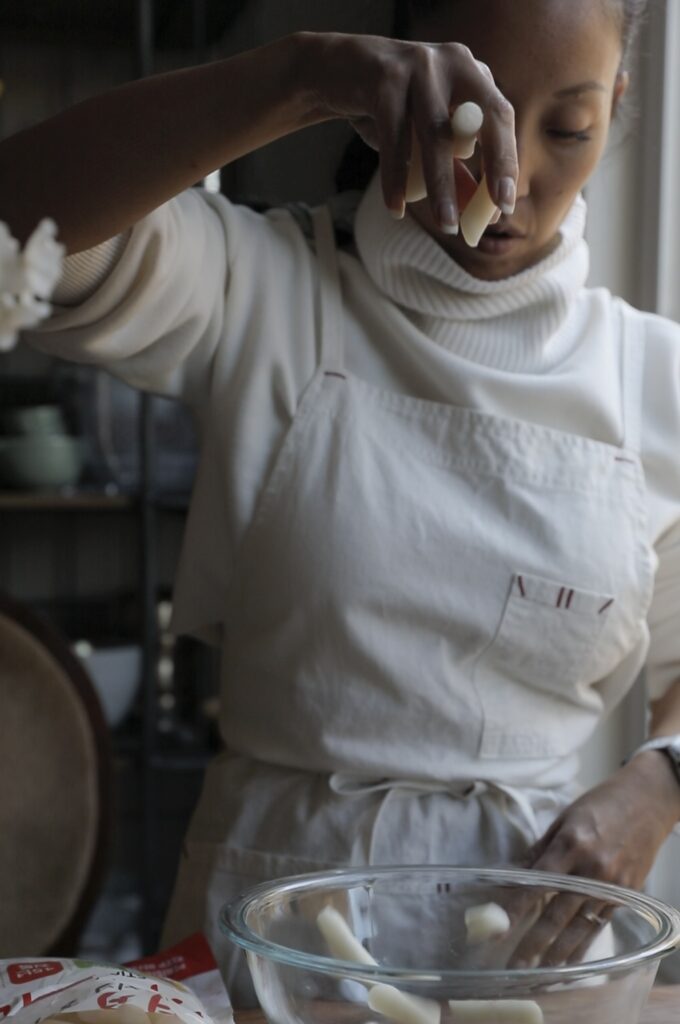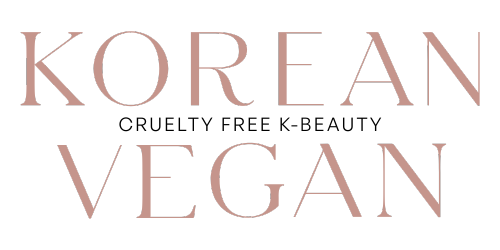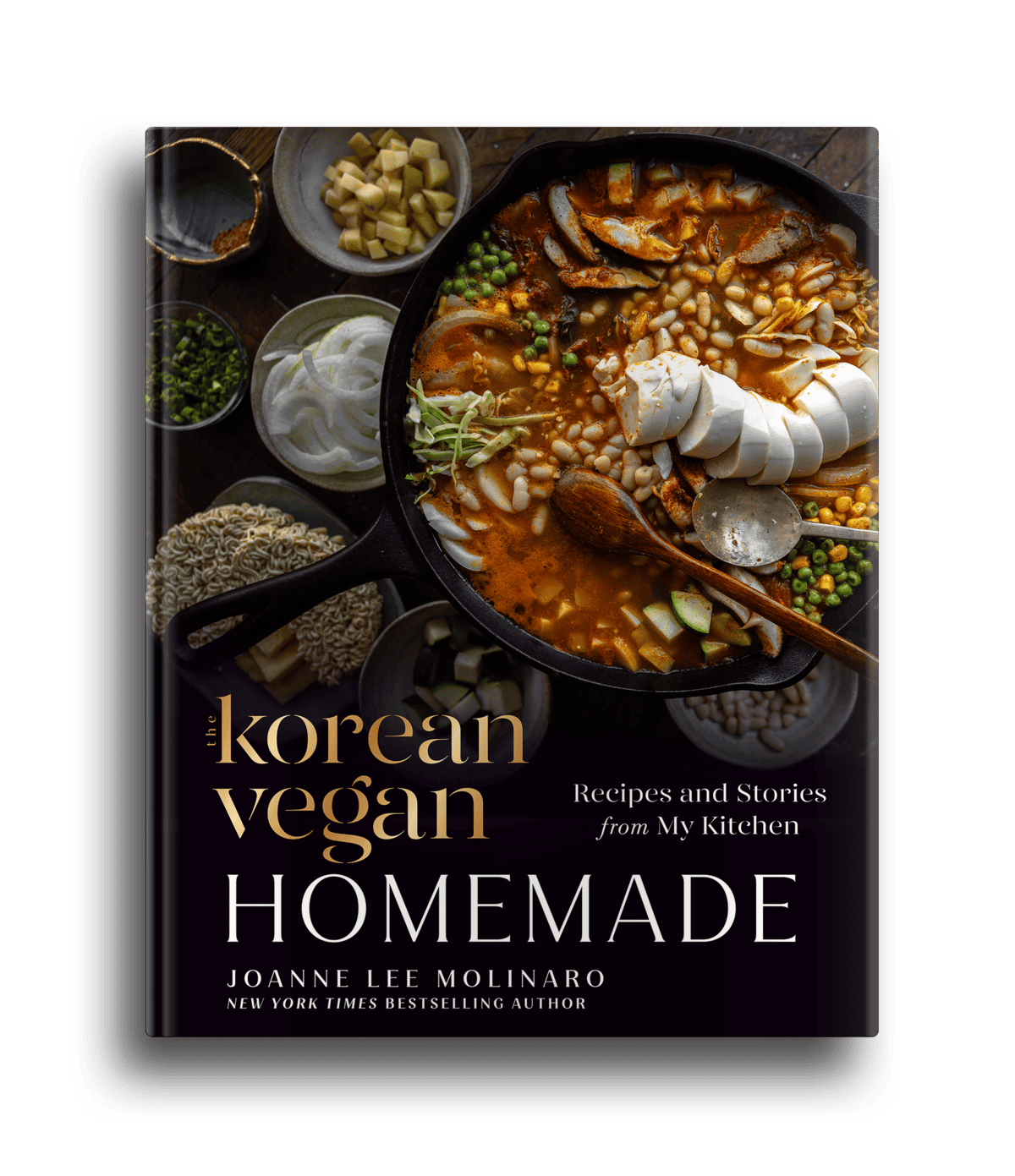My Cookbook Story: From Hobby to Publication


Receive the TKV Newsletter in Your Inbox Every Tuesday!

On October 12, 2021, my book, The Korean Vegan Cookbook: Reflections and Recipes from Omma’s Kitchen, was published by Avery, an imprint of Penguin Random House. The book became an instant New York Time’s Bestseller and a few months later, picked up a James Beard Award. It was selected as one of the Best Cookbooks of 2021 by both the New York Times and The New Yorker.
This week’s newsletter will spill all the gory details leading up to the book’s publication. So, if you’ve ever wanted to publish a book or wanted a more practical bird’s eye view of making your dreams come true (literary or otherwise)… this one’s for you.
As I discussed in this newsletter, I started writing a lot more in 2010, mostly by accident. I’d opened a Tumblr account to share the photographs I’d just started shooting on a DSLR (Digital Single Lens Reflex camera), as well as to follow other photographers. But, I soon stumbled upon a small, tight-knit writing community on this new and exciting blogging and social networking website, one structured loosely around the hashtags #writing #poetry and #prose. Although it had been years since I’d done any writing that didn’t look like a demand letter or motion, I knew I could write as good as, if not better than, the other “writers” publishing their poems and short stories on Tumblr.
I thus posted my very first poem [no, you can’t find it anymore, I deleted my entire Tumblr account after getting cyber-stalked by someone who was actively trying to destroy my life…that’s another story!] and quickly grew addicted to the instant feedback I’d receive in the form of hearts, reblogs, and comments.
When I started The Korean Vegan in 2016, it was just the name of my YouTube and Facebook accounts, nothing more. Why did I start said YT channel and FB page? One morning, Anthony marveled at how well I’d adjusted to our new diet (recall, I was very reluctant about the whole thing) and said, “You’re more vegan than I am! You’re the Korean Vegan!” He then followed that up with, “Your food is so good, you should start a YouTube channel sharing all your recipes!” I started my channel that night.
I posted photos of my vegan creations and sometimes jotted down the recipes on the Facebook page and attempted, very badly, to make long-form videos, like this one. Shortly after that, I started an Instagram account under the same name, which meant that I stopped posting videos on YouTube. I operated exclusively on social media accounts for months before plunking down a little money to create a website.
It wasn’t until 2017, when I decided to brush off some of the writing skills I’d developed on Tumblr, that I began to drop stories instead of recipes in the captions of my Instagram photos.
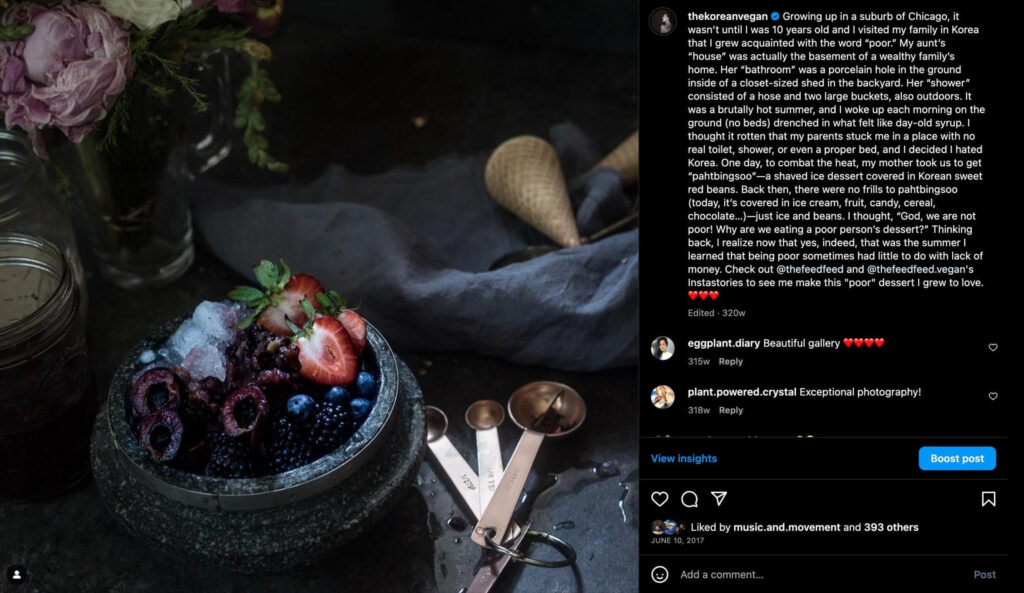
How I Met My Literary Agent.
By that time, I’d garnered the attention of a popular vegan Instagram account called “Best of Vegan,” owned and run by a woman named Kim-Julie Hansen (you can read more about her here or listen to her incredibly riveting story here). Based upon just the little snippets I posted here and there on Instagram, she told me she liked my writing so much that she wanted me to write a book. And wouldn’t you know it–she was working with a literary agent to write her own book and asked if I would be interested in meeting him.
At this point, after a year and a half of sporadic but enthusiastic posting, I’d amassed close to 20,000 followers on Instagram, a few thousand on Facebook, a couple thousand on Snapchat, and a trickle of folks visiting the website. Sure, it was nothing to sniff at, but I had zero thought of monetizing The Korean Vegan. It was just a hobby–one that was subject to the ups and downs of my demanding legal practice. While I’d heard of other food bloggers (like Kim-Julie) who managed to secure incredibly lucrative book deals with legitimate publishing houses, I assumed that those things were reserved for influencers with, well, far more influence than I possessed.
But, it would be rude of me to not at least speak with Kim-Julie’s agent, especially given that she was willing to go out on a limb and set up an introduction, right…? Rude and…
STUPID!!
In retrospect, I think I’d convinced myself that neither he, nor anyone else, would ever want to work with me to write a book, so as to prevent the crushing disappointment I’d feel when any hopes in that regard were dashed. But Charlie, the lit agent from London, turned out to be exquisitely polite and very affable.
I vividly remember our conversation. I was sitting in my office at work. This was before the Firm’s massive renovation and probably because I’d always been very nice to the Office Manager, Doug, when I made partner, I was awarded with a corner office with views overlooking the sparkling river. Doug also made sure I got my pick of the litter from the Firm’s furniture warehouse–I had a beautiful and spacious pine desk with a matching pine bookcase, a vintage satin-upholstered loveseat, and an onyx-granite topped credenza on which I sometimes propped my feet, especially when everyone else had left for the day and it was just me, the river, and the gauzy lights of traffic at work for the remainder of the night.
I was sitting on the ergonomically designed chair we’d all been given–a techy piece that looked rather out of place with the elegant furnishings I’d taken pains to pull together–but instead of facing my spacious pine desk, I was facing the phone on the credenza behind me, my knees tucked in so they wouldn’t collide with the wood. The fingers of my free hand tangled with the cord as I hunched over the phone, as if trying to shorten the distance between myself and Charlie’s London office.
He’d taken a look at my Instagram and website, and therefore had a good sense of what I was about–from my writing, to my photography, to my recipes. And then he lobbed the question:
“So, do you want to write a book? It doesn’t have to be a cookery book. It can be a novel, a memoir, or some other kind of non-fiction.”
I considered his question for a moment. It had never occurred to me that I could write anything other than a cookbook. Whatever scribblings I jotted down in my Instagram caption were just that–scribblings. They weren’t “real writing,” I thought. Charlie’s faith in my capacity to string enough of those scribblings together to write an entire novel was, in a word, unexpected.
The truth was, of course, that like many avid readers, I’d secretly harbored the dream of one day writing a novel. In fact, I’d already started one. Diana. I even knew the name of the first chapter, “The Long Leaf,” in reference to the long leaf pines I’d fallen in love with during my escapades to the cape shortly after separating from my ex. I’d gone so far as to write the first chapter–a total of 573 words that I loved, but with that secret shameful kind of love, the kind you might have for chocolate chip ice cream or another woman’s husband. I’d never shared a word of it with anyone before.
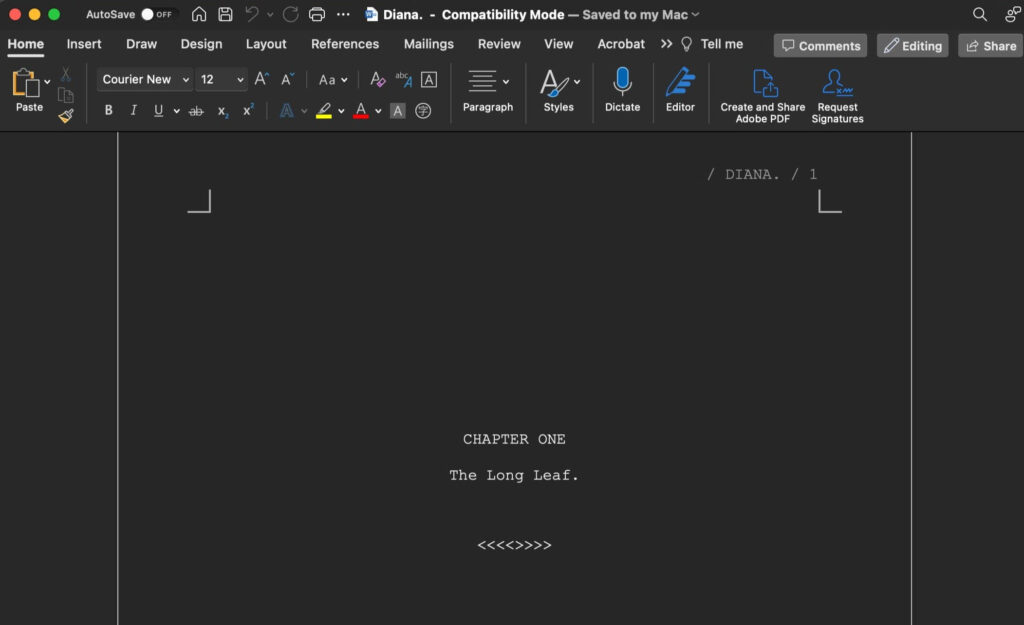
I answered Charlie carefully:
“I think I should just stick with a cookery–er, cookbook. I mean, that’s all I probably have time to do anyway!”
Writing The Book Proposal.
Charlie tasked me with writing a one-pager, something that described what I wanted the book to be about. This took me about a month. In it, I described how I wanted my book to be more of a food-memoir or a foodoir: something that mimicked my Instagram account–fewer recipes, more narrative style writing. After reviewing my one-pager with me, Charlie provided me with sample book proposals and asked me to turn one around in the next several weeks.
Although I dutifully reviewed the sample proposals that Charlie sent over, I’d already had one I was using as a template for my own–sort of. I’d spent a few hours surfing the web on how to write a book proposal, even before Charlie had assigned it to me. I’d landed upon a blog post by Heidi Swanson, the author of Near and Far–a beautiful vegetarian cookbook. In it, she takes you through all the necessary parts of a successful book proposal, but I was more taken with the look of her proposal–the faded, hoary snapshots of her travels, the food they inspired, the quiet revelations in her charming kitchen. I wanted my own proposal to be visually stunning, full of photographs that transported the reader from the outset.
So, in true Joanne fashion, I ignored the parts of the proposal I didn’t want to write (i.e., the marketing plan, demographics, competitor books), and instead focused on pulling together my favorite photographs as options for the “cover” of my proposal (I used Adobe InDesign to create a little booklet). I included about 15 screenshots of all my favorite Instagram posts, together with numerous comments saying I should write a book.
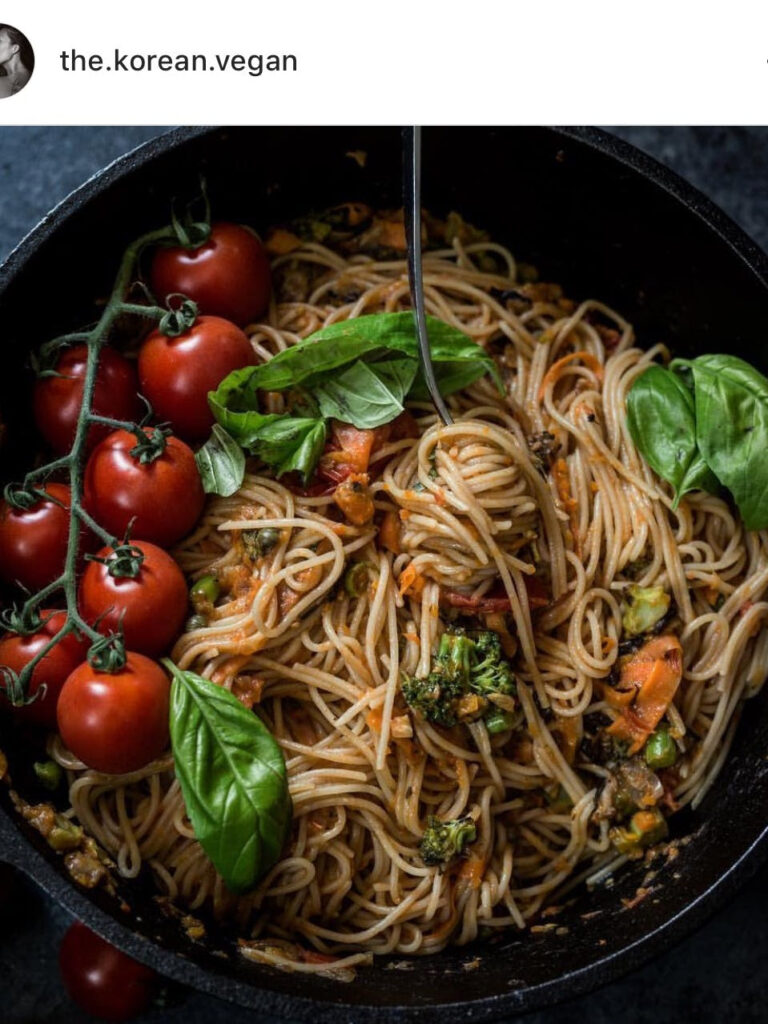
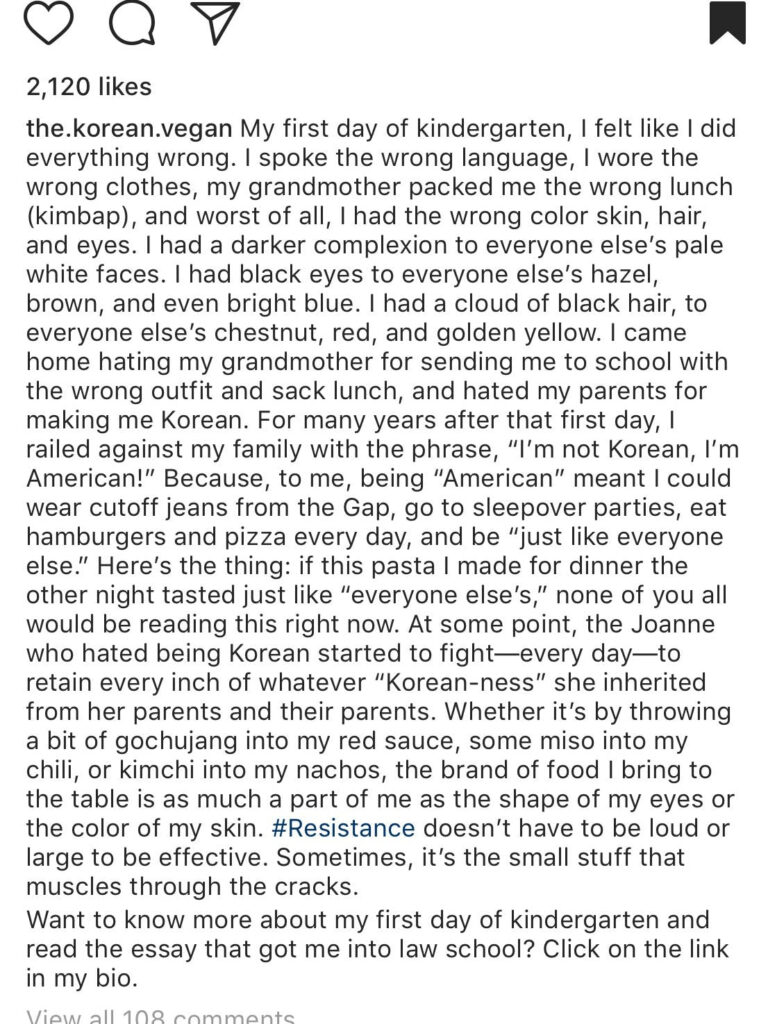
I handed it into Charlie thinking I’d done a real bang-up job. But, a few weeks later, I had the opportunity to review another book proposal, one that had been accepted by a real live publisher. It was clean, elegant, easy to read, without the messiness of screenshots. More importantly, it included all of the sections I’d neglected to put in mine. So, I went back to Charlie and asked him for his “brutally honest opinion.” He was polite (I think his DNA actually prevents him from being anything but perfectly courteous at all times, even when he’s irate):
“I think publishers might want to see something that might be a little bit more conventional…”
I went back to the drawing board. I scrapped a lot of the 27 pages in screenshots and whittled it down to a handful. I added a marketing plan, a section with competitor books, and an “About the Author.” In the end, the book proposal came out to roughly 45 pages with the following structure:
A. Introduction: I wrote a short essay describing what my book was to be about. B. Chapter Titles and Descriptions: I included example recipes for each chapter. C. Sample Chapter / Recipes: I wrote an original essay, together with recipes I’d already published on my Instagram. D. Competitor / Similar Books: I had to do some research here and identified books that were similar to the kind I wanted to write. I also talked about the rise of plant-based food and the popularity of Korean cuisine. E. Marketing Plan / Potential Endorsements: I listed a bunch of people who had a lot more followers than I did who might be willing to endorse my book, most of whom had become good friends by that time. F. Social Media Statistics: I put together a graphic that provided all my Instagram, Facebook, YouTube and Snapchat statistics. G. About the Author: I found this to be the hardest part to write, but I basically drafted what I imagined would be on the inside cover of the book. H. Appendix: These were all the Instagram screenshots of posts, captions, and comments.
I submitted the final book proposal in April 2018. Charlie emailed the proposal to a number of different publishing houses in the United States. Within about 9 days, I received a call from Charlie indicating he’d heard back from Avery, an imprint of Penguin Random House.
Auditioning with the Publisher.
Charlie arranged a one-on-one interview with the editor at Avery. Avery focused on books related to health. They adopted a 360° view on wellness, meaning they not only published books on nutrition, but also on fitness and mental health. One of their most popular books of all time, Atomic Habits, has been on the NYT Best Sellers List for over 192 weeks.
Once more, I was huddled over the phone in my office with the cord twined around my fingers. I was excited and terrified at the same time (an emotional combo I adopt quite frequently). But, although based in Manhattan, Lucia was about as un-New York as I could have imagined: friendly, down-to-earth, and altogether Midwestern as she chuckled at my nervous jokes and drew out the vowels in her words. She asked me why I became vegan, what kind of cookbook I wanted to write. She complimented me on my photographs and told me how delighted she was to discover I could also write. She didn’t have to explain what she meant by the latter, but I can tell you all now how thrilling it was to hear that from an actual editor at an actual publishing house.
And then, because it’s the polite thing to do in any interview, I asked her to tell me why she was interested in publishing books about health. She confided that someone in her family had gone through a rather challenging illness, how it impacted everyone around them, and that she was thus inspired to work with authors that helped to make life a little better.
We ended our call and I went back to billing hours, thinking the chat had gone relatively well. Of course, I was making my evaluation in a vacuum–I didn’t even know what role this interview had on whether I’d receive an offer, let alone what that offer would look like. As I often do in these situations, I assumed the worst and hoped for the best.
The Offer.
Charlie heard from Lucia shortly after my interview, and based upon that, he told me that he expected an offer to be forthcoming. Anthony and I dove into the internet to see what sort of number we could anticipate. He went back to his concertizing days when record labels and managers were courting him and suggested an offer for a first time author like me would probably be between $5-10,000. Based upon my own research, I also expected somewhere around $5,000. Maybe, if I was lucky, I’d get somewhere north of $14,000.
The offer came in a couple days later. While I cannot disclose the actual amount, I will say that my jaw hit the freaking floor. It was a very “healthy” 5-figure number and a lot higher than either Anthony and I had anticipated. But apparently, it wasn’t high enough. Charlie went back with a counteroffer and within a few days, he was calling to tell me that Avery had increased their offer. By this time, I was starting to get nervous and told Charlie, “Maybe this is too much?”
I know what you’re thinking:
“How could anything be too much?”
Recall that the “offer” actually consists of both an advance and royalties:
Advance. A lump sum that is paid to the author, usually in installments, before the book is published. This amount is paid to the author against future royalty earnings, which means that for every dollar the author receives in an advance, the author must earn a dollar from book sales before they start receiving any additional royalty payments. The advance is designed to fund the author’s expenses while writing the book. That said, the advance is guaranteed, meaning the author does not have to repay any money they fail to earn through book sales.
Royalties. A percentage of book sales due to the author after the advance has been paid off. The royalties are usually graduated, such that the percentage gets higher the more books you sell (e.g., the first 10,000 books will be at 8%, the second 40,000 at 9%, the third 50,000 at 10%, etc.).
A very simple example to illustrate the concept: If an author receives a $10,000 advance with a 10% royalty, they would need to sell 5,000 books at $20 ($2 per book) for the publisher to recoup the advance. After the advance has been recouped, or repaid, the publisher pays royalties to the author on subsequent sales based on the percentages outlined in the contract.
Although the whole advance thing was a little murky to me at the time (I didn’t know with 100% certainty that I wouldn’t have to pay it back), I viewed the amount of the advance as directly correlated to the amount of faith the publisher had in me. While flattering, the bigger the number, the bigger the pressure. At the time, I had around 35,000 followers on Instagram. While each and every one of those was hard earned, I didn’t know if I could sell enough books to break even, let alone make $1 of profit. Moreover, I didn’t need the money–I had a full time job already. I figured the lower the bar, the more fun I could have with the whole process.
Don’t get me wrong–I was overjoyed at the amount of the advance. My mother was totally dumbstruck. She eventually verbalized what I was thinking:
“How could anyone agree to pay you that much for something you haven’t written yet?”
So, I accepted the second offer and signed with Penguin Random House in December 2018.
I will pause here to share that having now spoken with many other cookbook authors–including those that started out as food-bloggers–it appears that the book advance I received was right in line with the prevailing market at that time. From what I understand, in today’s market, a first time author with a substantial social media following (100,000+ followers) can expect an advance in the low six-digit range.
The advance is typically divided into four parts: (a) half at the time of signing, (b) a quarter at the time of manuscript acceptance, and (c) a quarter at the time of publication. Thus, even though the amount might seem very high, the author will see only half of it (less, if they need to share that with their agent) when they start writing the book. For instance, an author will receive a check for $50,000 at the time she signs a $100,000 book deal, another $25,000 when the publisher accepts the manuscript, and another $25,000 when the book is finally published. If the author is able to finish the book from start to publication in a handful of months, this can be a pretty lucrative deal. But if she spreads this out over three years… (looking in the mirror…), it’s not something that can easily take the place of your day job.
How I Wrote My Cookbook – The Recipes.
I recently described how I wrote my cookbook to a woman I met at a party. After I concluded with, “And that’s how I wrote my cookbook…,” there was an awkward lull before she said, a little incredulously, “I’m sorry, did you say you won a James Beard Award?”
You see, I wrote my cookbook in much the same way I did my Instagram–sporadically. I would come home from work, cook something for dinner, and if I felt like it, I’d put it in one of my nice bowls or plates, prop it up on a small card table with a piece of repurposed wood on top, and snap a photo or two. Sometimes, I’d remember to jot down the “recipe,” but more often than not, I’d dig into my food before remembering to write anything down. These were all “recipes” I’d made dozens and dozens of times, with minor variations. To the extent I was making something I’d never tried before, I’d scribble a few notes in a small, black notebook I stowed away in the top drawer of my desk (the same notebook I used to take to Bible Study in college…).
In retrospect, this wasn’t the best way to write my cookbook; however, it wasn’t like there was a handbook going around called “How To Write A Cookbook” for first time authors (or if there was, I didn’t get a copy). Although my editor had me write down a list of 50 recipes before I got started, we both knew that these were more of a guideline. They weren’t set in stone. Furthermore, although the contract gave me a full year to hand in my manuscript, even that seemed fairly flexible. I therefore went with what I knew–which was how to develop recipes and take photos for Instagram.
Still, I did want to challenge myself as an artist and viewed the whole book-writing thing as an opportunity to grow as a photographer. Thus, towards the end, I flew in one of my favorite food photographers in the world to provide me with hands-on instruction on food styling, composition, lighting, and editing. I rented out a loft style studio in Chicago’s South Loop, just a few blocks from my condo at the time, and invited my mom, two aunts, and cousins to help me cook, style, and photograph more than a dozen recipes. We had a blast and it was exciting to know that the finish line was right around the corner.
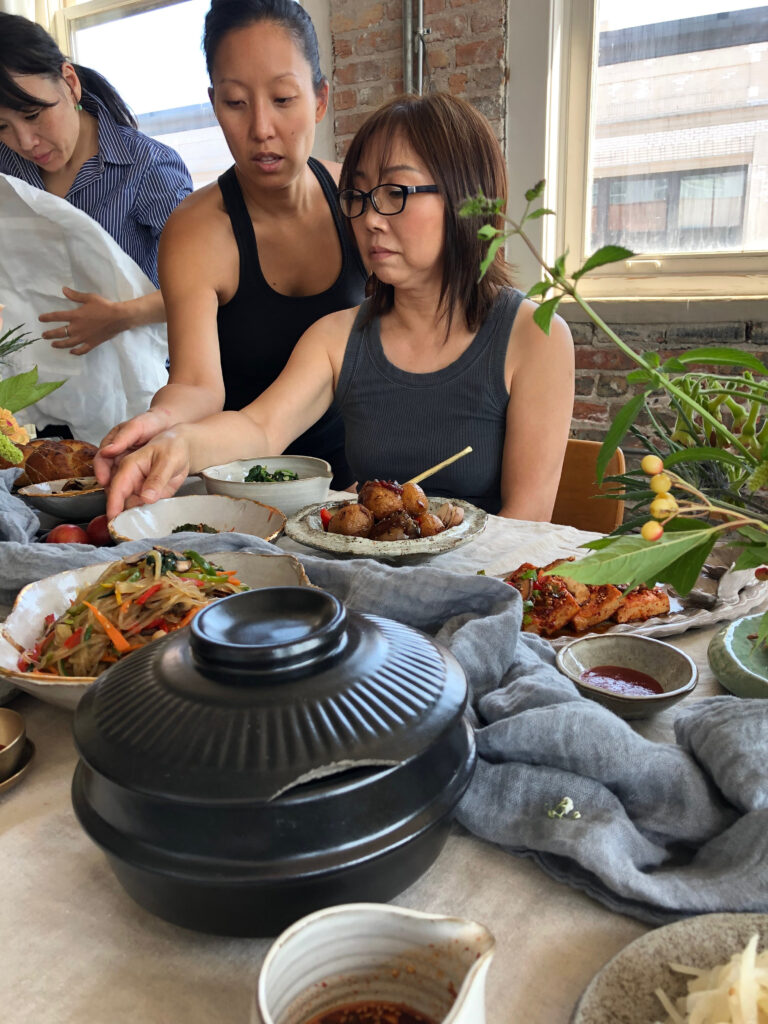
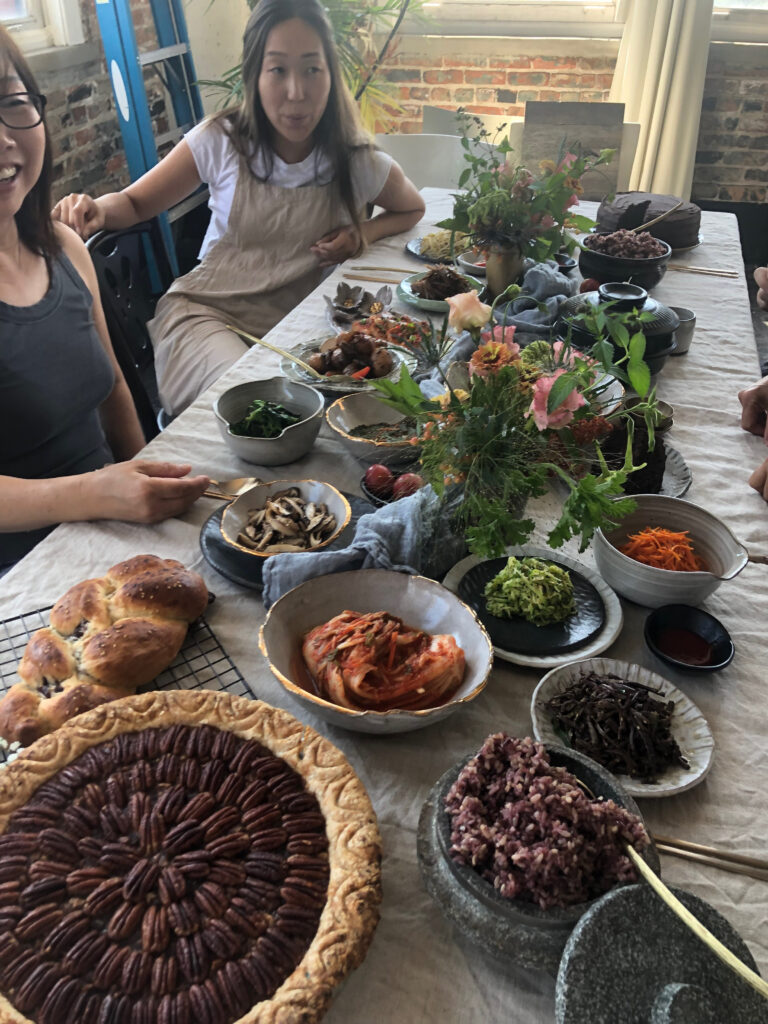
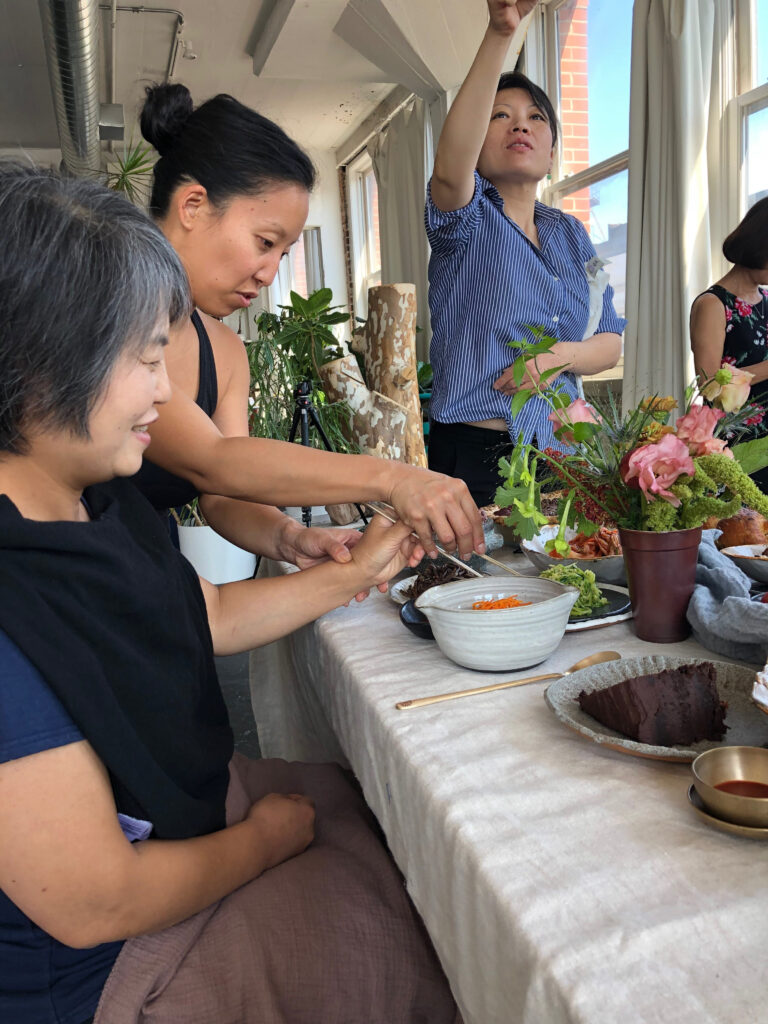

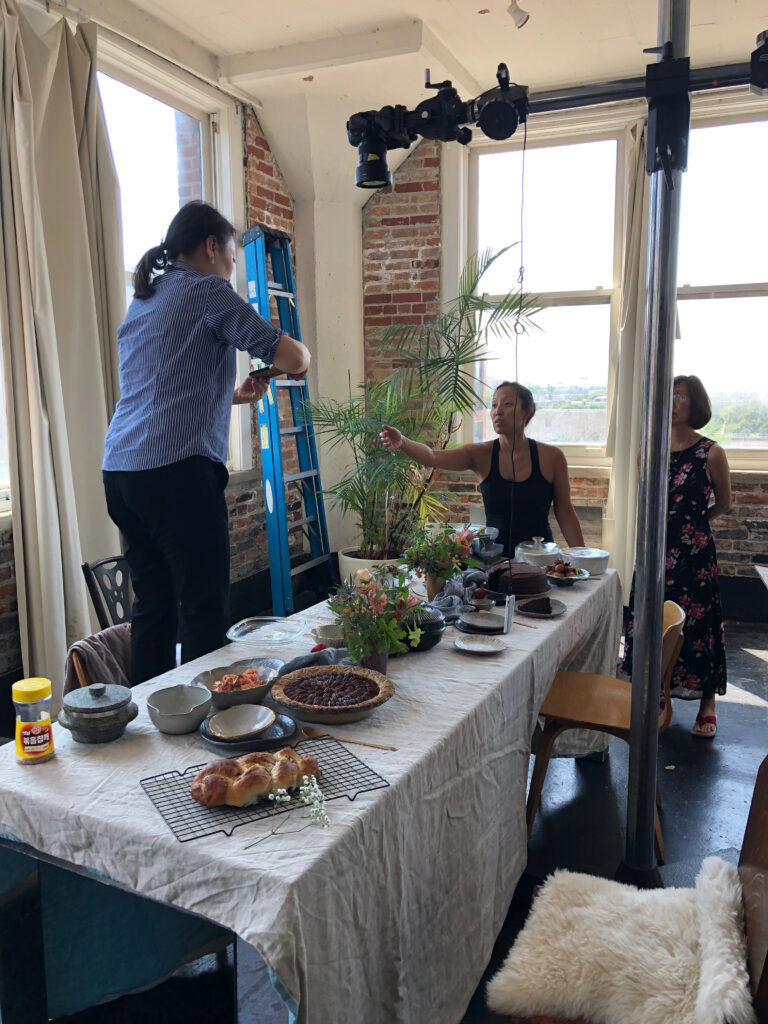
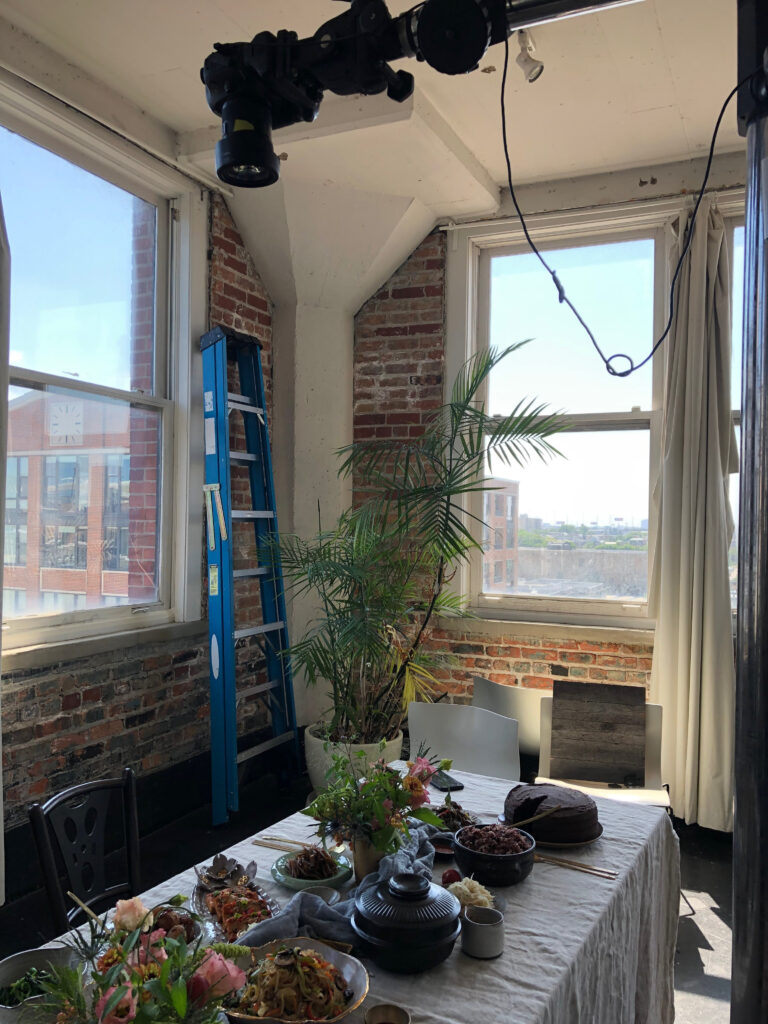
Unlike many cookbook authors, I did not spend any of the advance hiring a photographer. Not only would that have meant coming out of pocket (experienced, quality food photographers can run well in excess of $50,000), my editor made it clear that part of what they wanted was my photography. I focused on recipe development and photography first, thinking this would be the more challenging part of writing the book. By August 2019, I had all 50 recipes photographed and edited.
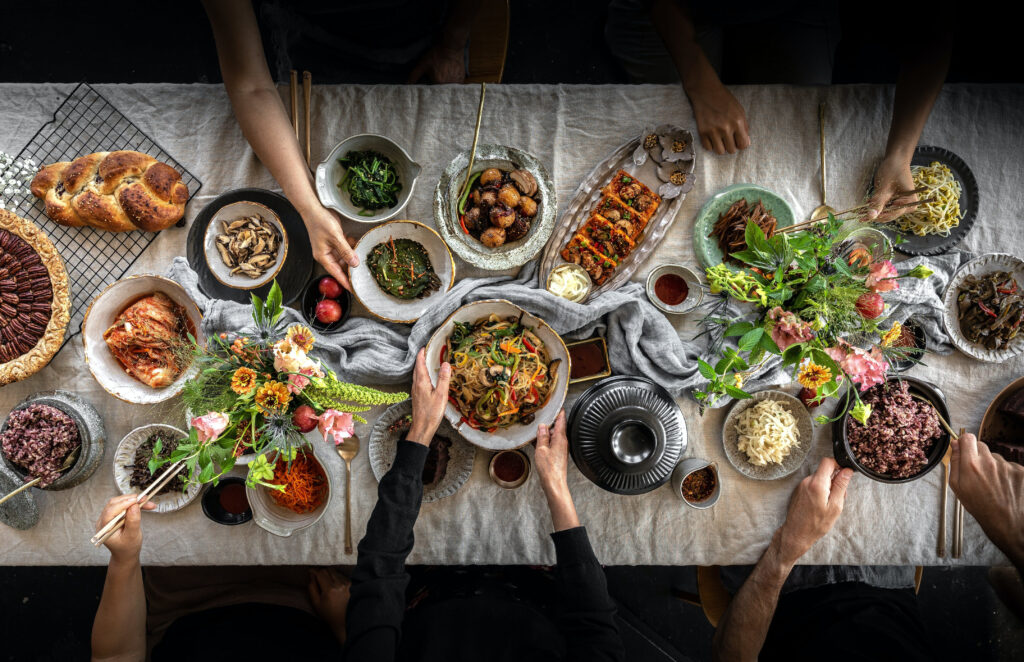
But, I still had to write the recipes down, come up with headnotes (the paragraph or two that introduces each recipe), along with the story.
How I Wrote My Cookbook – The Story.
Remember when I said that in retrospect, this wasn’t the best way to write a cookbook? Well, by the time I sat down to actually do some writing, I sorely regretted not taking more detailed notes while I cooked. In many cases, I had to re-engineer the recipes from the photos I edited and in some cases, I had to remake them altogether (yeah, not very efficient!).
But all of this was a total cakewalk compared to the part I thought I could complete in a week: writing my family’s story.
As I mentioned at the outset, I pitched my book as a foodoir: half recipes, half memoir. I wanted my book to celebrate not just Korean food, but the people who made Korean food. This was in line with the reason I started sharing my family’s stories on Instagram–to show people that though immigrant families might seem a little different, they were no less American than any other family.
Part of this meant getting up and close and personal with that story. Although I’d heard bits and pieces of my parents’ stories, I’d never taken the time to pull all of it together in any cohesive way. I’m ashamed to say this now, but it wasn’t until I had a deadline looming over me that I finally had the guts to ask my parents, “So…like…what was it like growing up?”
Luckily, my parents were incredibly cooperative, even generous. They both wrote up their “life stories” in two separate Word docs, which they subsequently emailed to me.
Reading them made me weep.
Reading them made me proud.
But writing their stories in my own voice?
Made me want to bash my skull into the wall.
I honestly don’t know for sure why I found it so hard to write my parents’ stories. After all, I’d been sharing shorter, abbreviated versions on Instagram for nearly two years. I kept telling myself that I just needed to add more words to what I would write in an Instagram caption. In fact, I started writing the essays in my Notes app, the same way I’d draft up captions. But none of it helped. Writing down the story about my mother and the chocolate bar–one I’d heard maybe 20 times–was like pulling teeth. Telling the story about how my paternal grandfather had to watch his mother poison herself was like trying to etch my name on a boulder with a No. 2 pencil.
Maybe it was just because writing more words is harder. Part of it was that I viewed this as my chance–my one chance–to astound everyone with my rhetorical brilliance, wow everyone with my lyricism. I signed up for an online memoir writing workshop offered by Gotham and managed to workshop the introduction that ultimately made it into the book. And somehow, I came up with about 35,000 words that attempted to tell my family’s story. But, I’m not gonna lie–my first draft of the manuscript?
It sort of sucked.
In fact, my own husband, who I tasked with proofing it, said, rather ungently:
“It isn’t your best work.”
Things didn’t go well after that. I had to repress the urge to throw something at Anthony and settled for screaming at him instead, after which I stormed into our bedroom and burst into tears.
I felt like a total failure, a complete sham. If my own husband thought it sucked, how could I possibly hand it into my publisher, let alone share it with the rest of the world?
I did the best I could, revising the manuscript at least 3 more times before I finally emailed it to my editor in November 2019.
By that time, I never wanted to see my own words again.
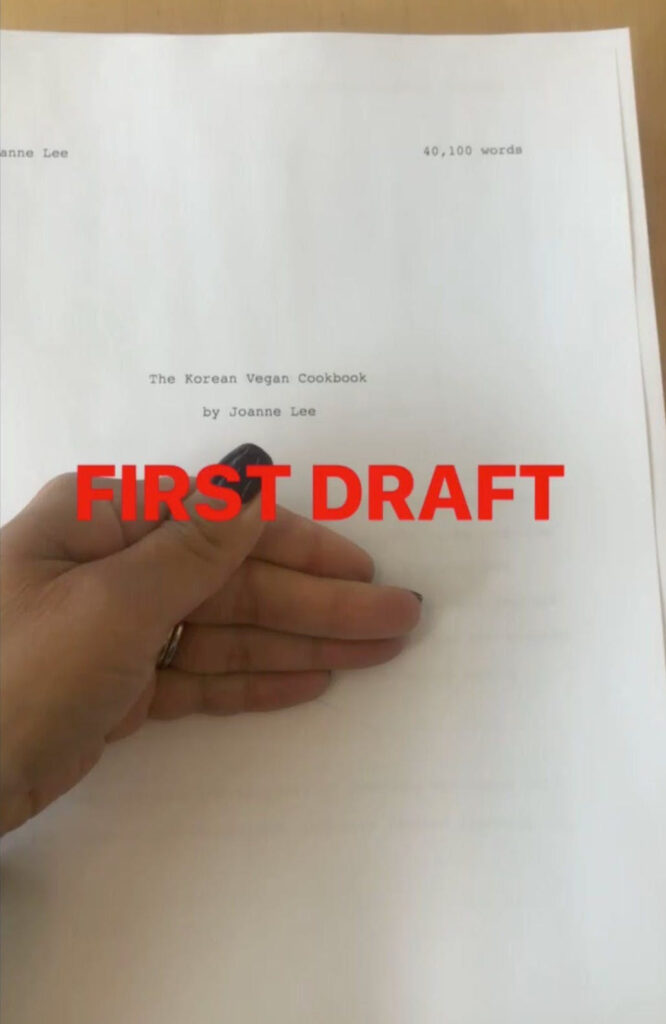
Too Many Stories.
My editor scheduled a call with me in February 2020. The gist of the call was this:
- Too much writing
- Not enough recipes
I took this to mean one thing:
“You’re not nearly as good a writer as I thought you were.”
After the call, I sat at my desk at the Firm. By this time, everyone had been moved into uniformly sized offices and I was thus back in a room that looked almost identical to the one I started with when I was an associate. The only difference? Glass walls that looked out into a pool of legal assistants, including my own. Tempting as it was, I couldn’t bury my head in my hands and start bawling, which was very much what I wanted to do.
Instead, I opened up a spreadsheet, my go-to when I’m feeling terrified. I came up with a list of 25 new recipes, the minimum my editor said I needed to add to make my book “more traditional.” I copied and pasted them into an email addressed to her, in which I committed to coming up with an additional 25 recipes, and per my editor’s suggestion, paring down my dozen or so essays to just two: an introduction and a conclusion.
Yup.
Just two.
The Pandemic, TikTok, and More Than Two Essays.
Less than a month after that call with my editor, the lockdown order came down from the Governor. Though I had access to my kitchen and studio all day long, tofu, flour, and yeast grew harder to acquire than caviar. I ended up having to order flour—FLOUR!–off the internet. As a result, it took me a couple months longer than expected to develop and photograph the 25 “supplemental” recipes.
During this time, I was in constant contact with my editor. Lots of emails, phone calls, and Zooms where we would go over the recipes, discuss questions, etc. I got the sense that she didn’t want another surprise–she wanted to know exactly what she was getting with the revised draft. On July 28, 2020, I handed in my revised manuscript, which included 25 brand spankin’ new recipes. And guess what? I snuck some of my old writing back into the draft, in the form of chapter introductions. I figured the worst that could happen would be that she would axe them. Again.
A week before I handed in that revised manuscript, I’d started posting on TikTok. A few weeks after that, my first “storytime video” (i.e., a video of me making food while telling a story–just like my old Instagram posts) went viral. I continued to post these types of videos on TikTok, and amassed a million followers by January 2021. My Instagram following also grew from 70,000 to about 400,000. This got my editor’s attention. We thus agreed that each chapter–all ten of them–would be preceded by a substantial essay, drawing largely from the ones I included in the original manuscript. Yes, they needed to be heavily revised, but they weren’t worthless after all.
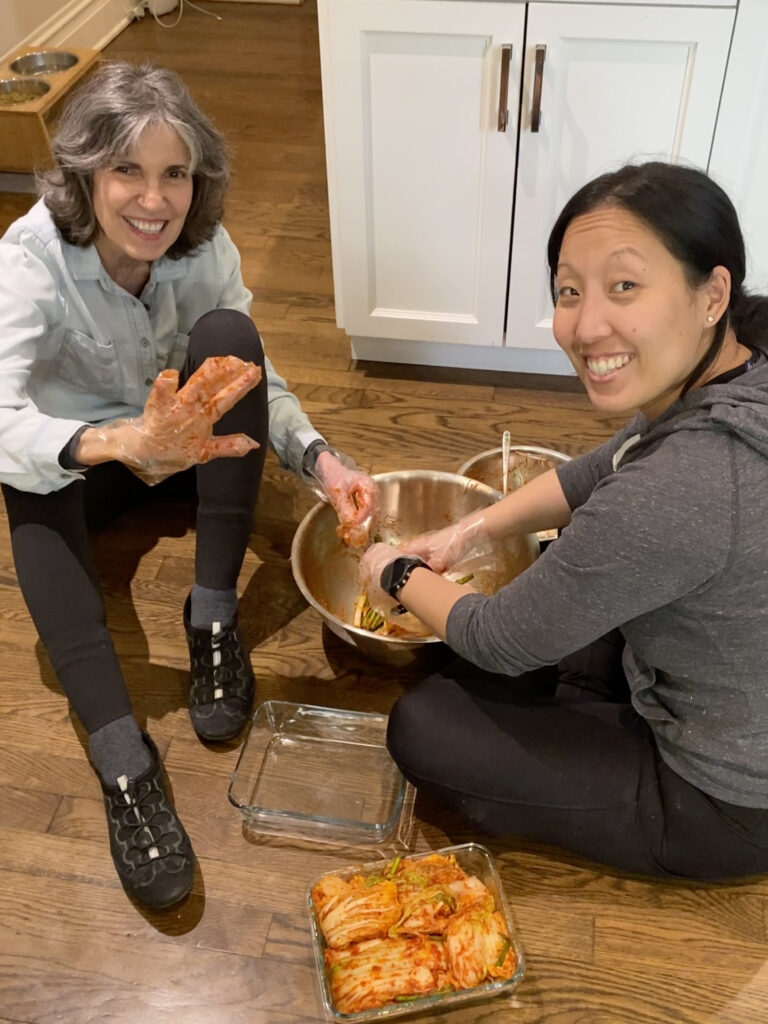
I spent the remainder of the year writing and revising the essays, working with my editor and a team of copywriters to clean up the recipes, and asking my family to help me with testing the recipes. One of my favorite memories of all time is getting down on the ground with my mother-in-law to make kimchi. It turned out perfect. Judy and Anthony also helped me with countless proofs, catching errors that eluded even the copywriters. I even asked one of my partners at work, someone who’d mentored me as a legal writer, to take a stab at commenting on my intro.
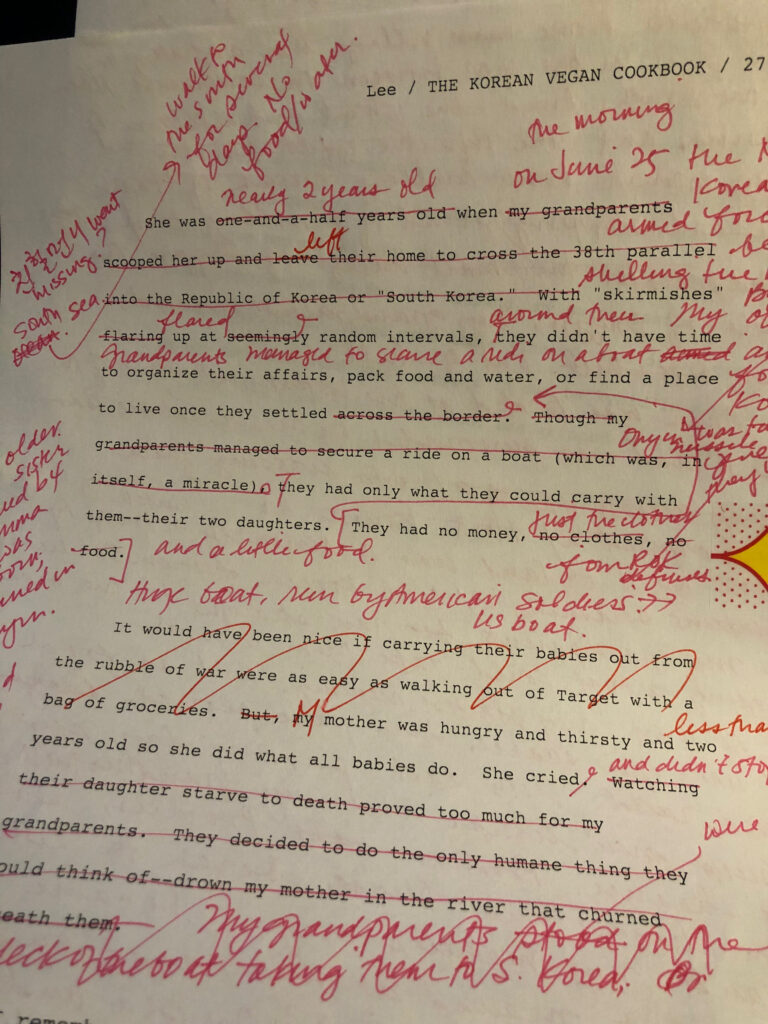
Eventually, I grew sick of my own book. Wanted to throw it out the window of our condo. But, at least Anthony came around to liking what he saw:
“It’s extraordinary,” he said. “You should be very proud.”
This Week’s Recipe Inspo.
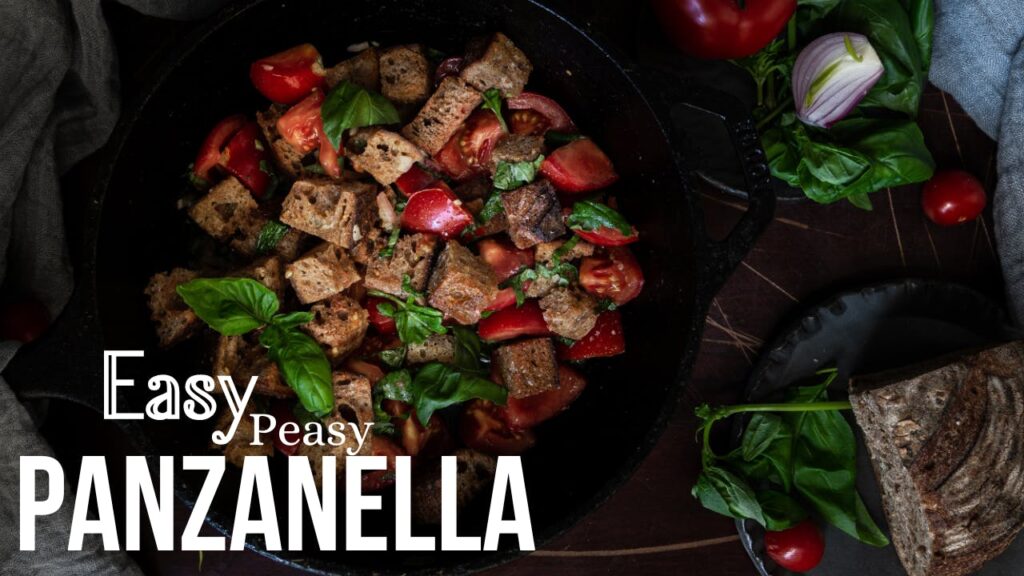
Ingredients
- 4 cups day old bread cut into 1 inch chunks
- 1/2 red onion chopped
- 5-6 Roma tomatoes chopped
- 3 tablespoon extra virgin olive oil
- 1/2 tablespoon balsamic vinegar
- salt
- pepper
- 6-7 basil leaves
Method
- Preheat oven to 475° F. In a large bowl, toss cubed bread with 1 tbsp of extra virgin olive oil, 1 pinch of salt, and a little black pepper.
- Place bread cubes on baking sheet in one layer, spread out (you may need to use two baking sheets). Place in the oven and toast until they start to brown (~7-8 mins).
- When bread is toasted, add to a large bowl, together tomatoes. Add 2 tbsp extra virgin olive oil, ½ tbsp balsamic vinegar, and another pinch of salt and black pepper. Tear basil into bowl as well, and then mix until all ingredients are well combined.
Spice Up Your Life.

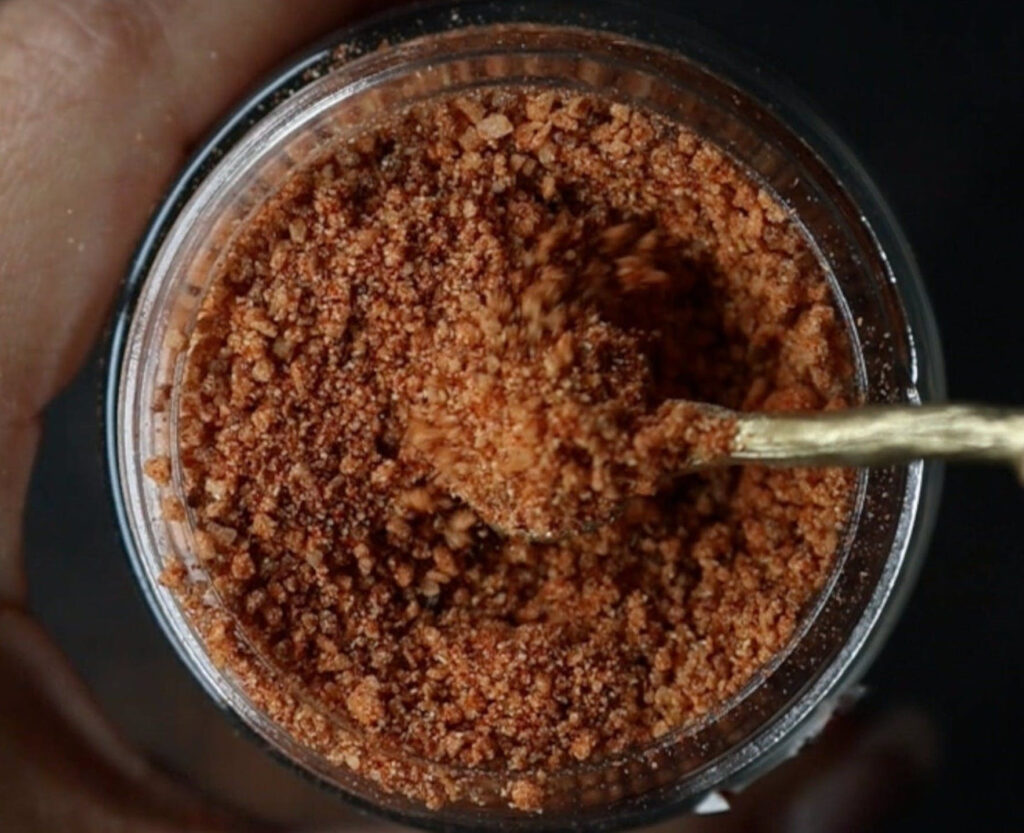
Spicy Ramen Salt
A spicy, umami packed blend of seasonings that’ll enrich your broths, pop your popcorn, and heat up your pasta sauce!
What I’m…
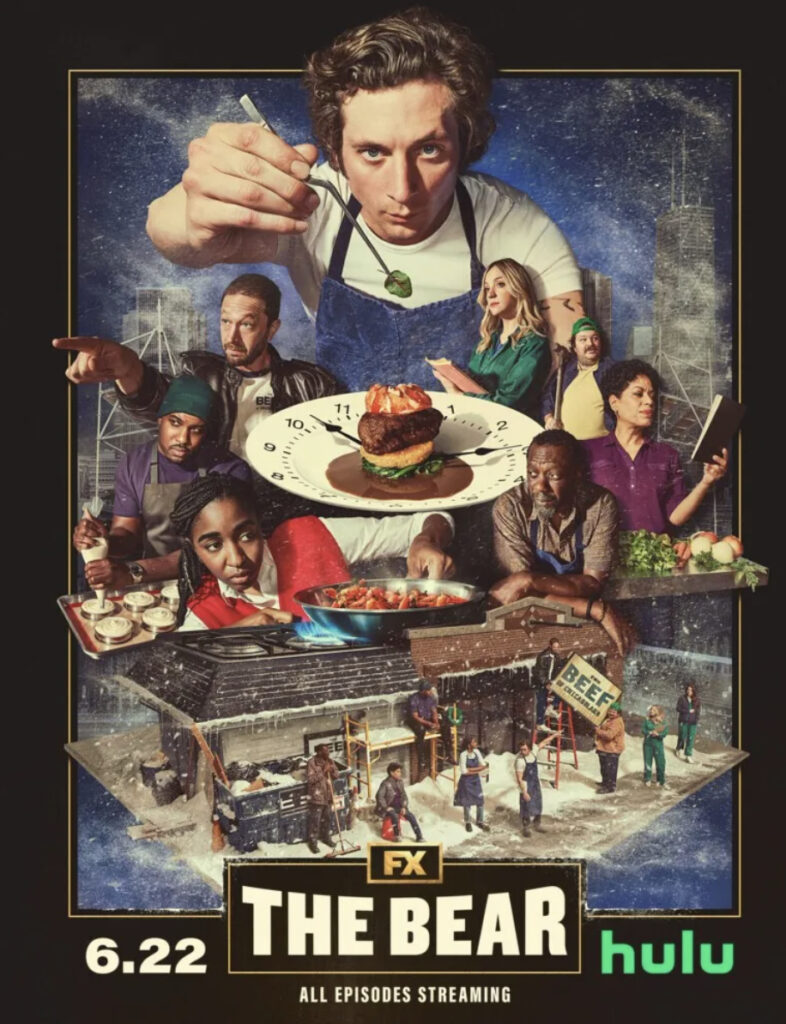
Watching. The hype is REAL. Season 2 was somehow even more addictive than Season 1. A beautiful investigation of the path from belly to heart, DO NOT MISS THIS!! Watch –>

Reading. An oldie but a goodie. This autobiography by Phil Knight, the founder of Nike, is inspiring, hilarious, and a fast read. I “read it” while running a long run and was unbelievably motivated to “Just Do It”! Read –>

Using a Lot. Summer means lots of outdoor running. For women, that means finding a place to stow your phone. I LOVE these sports bras because they let me run without my phone slowing me down! I have a dozen of them! Shop –>
The Korean Vegan Kollective
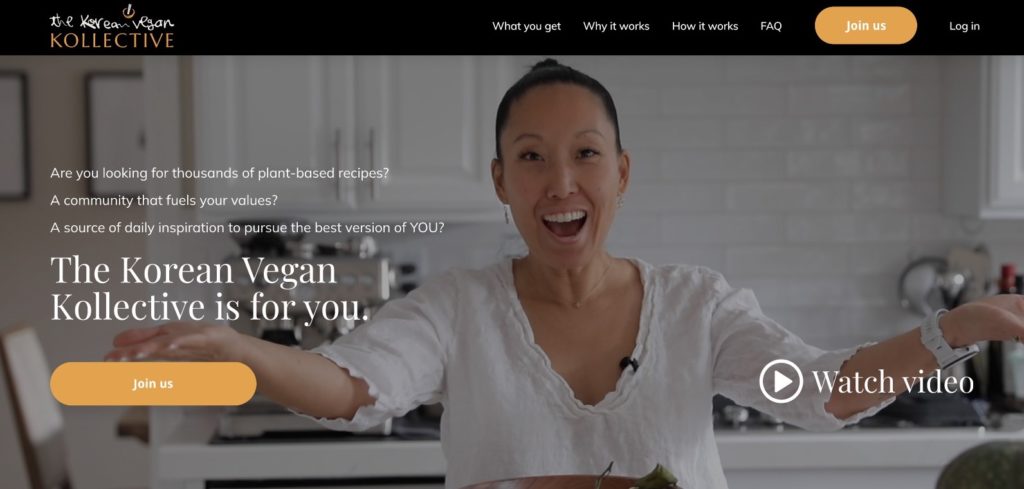
“My coaching session with TKV (Kollective food coach) was fantastic—my coach was very understanding, knowledgeable and helpful—I was pleasantly surprised. I recommend members take advantage of this resource.” ~ Michelle
Want instant access to thousands of plant-based recipes plus expert food and lifestyle coaching? Check out The Korean Vegan Kollective, a downloadable web-app that unlocks:
- 2,000+ delicious and personalized plant-based recipes
- complete nutritional information for every recipe
- integrated grocery shopping lists and grocery delivery in select areas
- access to one-on-one food coaching
- live cooking demonstrations
- exclusive articles and videos from me and my team
Parting Thoughts.
As I write this newsletter, my mother is sipping coffee at my breakfast table, with Lulu’s nose buried in her elbow (Lulu is our new rescue dog). Omma, her youngest sister (Eemo), my brother, and sister-in-law flew in from Chicago a few days ago to help me get past the finish line of Cookbook 2. I had a total of 92 recipes by the time they arrived at LAX–I needed 8 more to make 100.
Omma unpacked an assortment of vessels containing fresh squash, eggplants, red-tipped lettuce leaves, even a handful of cherry tomatoes that were so red they could have hung off a woman’s necklace. She’d picked them from her own garden. Her crowning jewel, though, was the double-sealed Tupperware holding some fermented kkenip (perilla leaves). As she handed it to me, Eemo piped up, “Remember when she used to take this to school with her??” to which Omma bragged, “School? Hah! She would take it with her to the office too!”
Between them, I felt the splinter, the small dagger they buried inside their bodies lest they get reprimanded from their children’s teachers, their managers, their colleagues for “the smell” of the food they knew, the food they made for their families, the food they had unwittingly believed would be ok to share with America. I watched the sliver wriggle out of them as if pulled by a magnet, their laughter belying their pride at the gall of the American daughter who brought kimchi to a fancy suburban high school in Wilmette, Illinois, to a big time law firm.
Less than 24 hours after unpacking, we started cooking. I started photographing. In all, we made 14 dishes. I asked my brother to bring in my mother’s Korean bapsang (dining table), the one that sits in the garage most of the time. Omma wiped it down until the soft brilliance of walnut shimmered beneath the windows in my dining room. We arranged all the dishes we made until it looked a little bit like the Korean tables of my childhood, but also a little bit like the dining table at my mother-in-laws’ home. A mountain of kimbap in the center, satellites of banchan, a chigae inside a ddukbaeggi as if a spicy moon, but also dinner rolls, a golden brioche loaf, and a chocolate cake–the glittering stars that rounded out our meal.
I snapped a few photos with my remote and said, “That’s a wrap!!” and the whole table burst into happy applause. Not for me but of us, a celebration of a meal well-cooked, a meal well-loved.
“I am so proud of you,” Eemo texted me from the airport this morning. “I believe thousand times that you are gonna have another successful cookbook.”
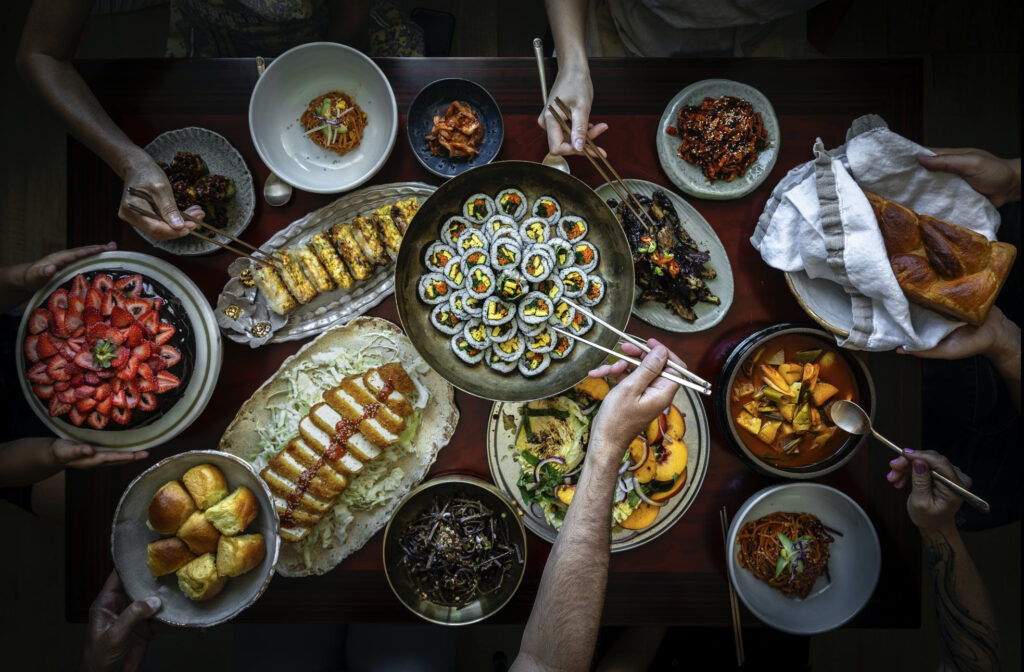
Until next week, I hope you have a lovely and wonderful day!!
-Joanne
Listen On:
APPLE | SPOTIFY | GOOGLE


